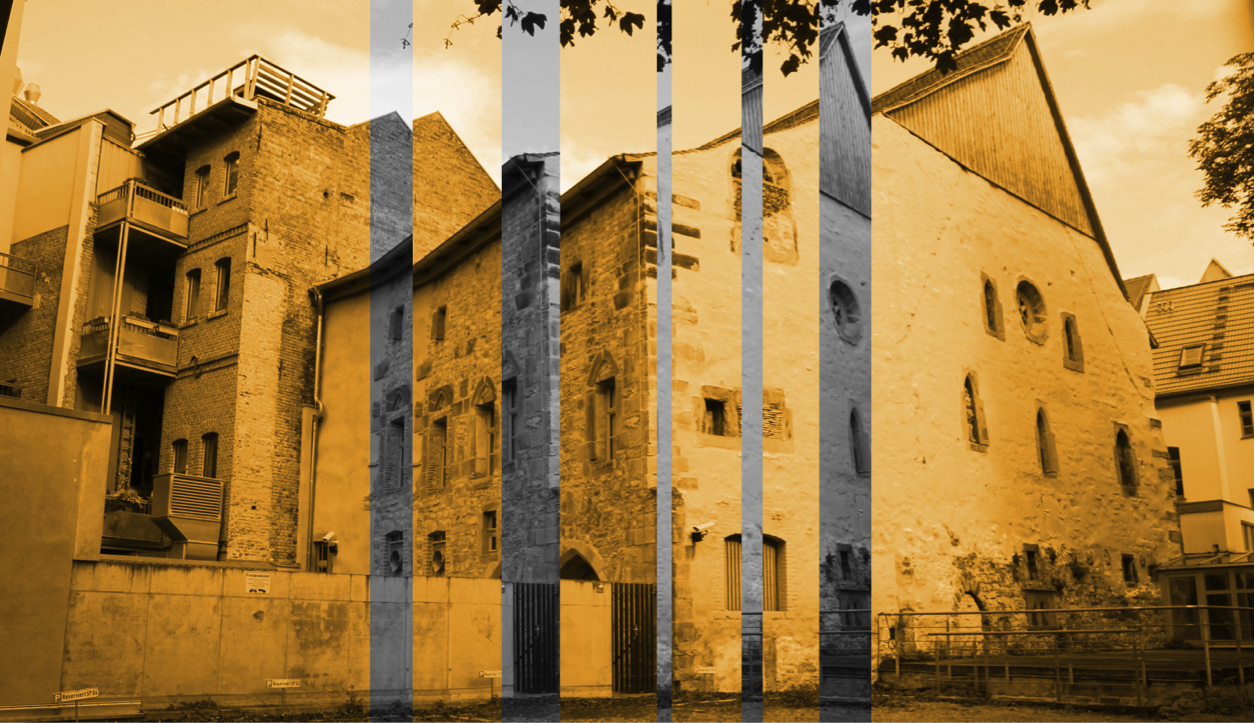Imagine: you are in Erfurt, a well-known historical city in central Germany, famous for its well-preserved Medieval monuments and a religious centre of a once-thriving eleventh-century Jewish community.
You are about to enter Synagogue Museum. As you walk through the museum’s contemporary entrance hall, you find yourself in a small courtyard. Frozen for a moment in front of the unique eleventh century monument you can’t help but carefully study the facade of it. It’s quite surprising to witness extended door entrance and brick-up former windows. You would probably even spot areas where bricks are old so have deep dark colour while others seem to have been put there not so long ago…
Stepping inside the building which is proudly has a sign “museum” you may expect it to be noticeable from the street but this one you need to have a steel determination to find. That indirect visibility is typical for medieval synagogue in quarters inhabited by Jews and Christians alike in order to protect a religious centre for possible pogroms from ardent Christ followers. This exact building in Erfurt is unique not only by being a monument of Medieval Jewish religious culture but also as a highly professional example work of restorers and conservators.
Thanks to their decision not to restore its original form, conservators present a series of historical uses for the synagogue in architectural layers. Therefore, we may gain a broader picture of what the building has been through from the eleventh century up to now.
Layer 1 : original one – SYNAGOGUE

Picture: © Mark Watson
Originally constructed approximately in the late eleventh century the building served as the religious centre of the Jewish community.
This first and the core historical layer still dominates through time. You can recognize it observing twelfth century extended storey, which may have housed either a women’s synagogue (traditionally separated from the main prayer room) or a school for Hebrew lessons.
It’s important to note that as it was in the Middle Ages, the synagogue is hidden away from the street. Today, the surrounding land is privately owned and the view of the western facade is hidden from public view. So representative western facade with five lancet windows and a large tracery rosette is not on public every day display. Due to that you may easily picture yourself what was it like back then when this place use to be inseparable part of the city religious context.
Layer 2 : WAREHOUSE
After the devastating pogrom of 1349 the city officials seized, and later sold the building to a local merchant who converted it into a warehouse. You can’t help but notice that part of the history in footprints of extended door entrance, vaulted cellar, where a part of museum collection is displayed nowadays, and into two storeys which were added at that time when the main prayer room was split up. As well the appearance of a roof truss is quite representative of that historical layer still speaks up for it impressively.

Picture: © Albrecht von Kirchbach
Layer 3 : DANCE HALL

(Image courtesy of Landeshauptstadt Erfurt Kulturdirektion)
In the late nineteenth century the former synagogue was once again transformed: from warehouse to restaurant. Up to late twentieth century the place was a popular local restaurant. That fact still surprises by the accepted possibility that once a sacred place could have been converted into a place to satisfy people’s hunger and desire to unwind. Due to the structural changes such as dining rooms, a kitchen, and a ballroom — as well as a shell of adjacent buildings, the medieval core was unrecognizable as a synagogue. Paradoxically, the layers of additions spared the building from destruction in the National Socialist era.
Nevertheless, this third historical layer is easily perceived once you carefully study the facade or go inside. You may see unified size of windows and even catch a visible remain of a kitchen chimney. On the top floor of the museum you will find yourself in the well-preserved twentieth-century dance hall and even some intact pieces of wallpaper are there to give you a full impression of the building’s complex story.
Layer 4 : MUSEUM
Overwhelmed with the process of revealing the presence of all historical layers that one place has, your eye would definitely want to study carefully each piece of the rich collection preserved within those walls. Housing museum on Erfurt Jewish community history in the Middle Ages finally the synagogue found a new appropriate use, adding a recent layer on the top of mentioned above.
Starting in the late 1980’s the synagogue building began gaining public awareness. In 1998 Erfurt purchased it and over the course of following years the building has been extensively researched and renovated.

Picture: © Papenfuss – Atelier für Gestaltung
We had a pleasure to interview Dr. Maria Stürzebecher, Commissioner for the UNESCO World Heritage of the Culture Directorate in the City of Erfurt who broadened a picture of the place and gave professional inside look at the museum itself and its history.
A visit to this place is inspiring by all means. This experience of peeling layers off in the context of one building is truly treasured. With a help of highly professional team this place nowadays accumulates the energy of all historical layers, giving us – visitors – a brighter picture on its history, city itself and Jewish community in it.
Inna Starkova & Anna Karla Almeida
XXXXXXXXXXXXXXXXX